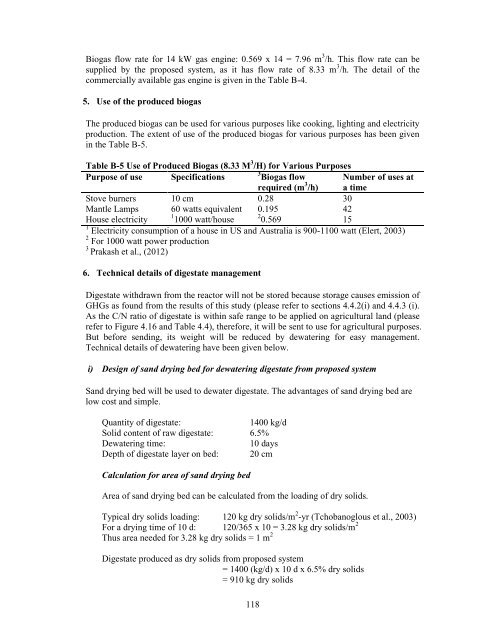dry anaerobic digestion of municipal solid waste and digestate ...
dry anaerobic digestion of municipal solid waste and digestate ...
dry anaerobic digestion of municipal solid waste and digestate ...
Create successful ePaper yourself
Turn your PDF publications into a flip-book with our unique Google optimized e-Paper software.
Biogas flow rate for 14 kW gas engine: 0.569 x 14 = 7.96 m 3 /h. This flow rate can be<br />
supplied by the proposed system, as it has flow rate <strong>of</strong> 8.33 m 3 /h. The detail <strong>of</strong> the<br />
commercially available gas engine is given in the Table B-4.<br />
5. Use <strong>of</strong> the produced biogas<br />
The produced biogas can be used for various purposes like cooking, lighting <strong>and</strong> electricity<br />
production. The extent <strong>of</strong> use <strong>of</strong> the produced biogas for various purposes has been given<br />
in the Table B-5.<br />
Table B-5 Use <strong>of</strong> Produced Biogas (8.33 M 3 /H) for Various Purposes<br />
Purpose <strong>of</strong> use Specifications<br />
3<br />
Biogas flow<br />
required (m 3 Number <strong>of</strong> uses at<br />
/h) a time<br />
Stove burners 10 cm 0.28 30<br />
Mantle Lamps 60 watts equivalent 0.195 42<br />
House electricity<br />
1<br />
1000 watt/house<br />
2<br />
0.569 15<br />
1<br />
Electricity consumption <strong>of</strong> a house in US <strong>and</strong> Australia is 900-1100 watt (Elert, 2003)<br />
2 For 1000 watt power production<br />
3 Prakash et al., (2012)<br />
6. Technical details <strong>of</strong> <strong>digestate</strong> management<br />
Digestate withdrawn from the reactor will not be stored because storage causes emission <strong>of</strong><br />
GHGs as found from the results <strong>of</strong> this study (please refer to sections 4.4.2(i) <strong>and</strong> 4.4.3 (i).<br />
As the C/N ratio <strong>of</strong> <strong>digestate</strong> is within safe range to be applied on agricultural l<strong>and</strong> (please<br />
refer to Figure 4.16 <strong>and</strong> Table 4.4), therefore, it will be sent to use for agricultural purposes.<br />
But before sending, its weight will be reduced by dewatering for easy management.<br />
Technical details <strong>of</strong> dewatering have been given below.<br />
i) Design <strong>of</strong> s<strong>and</strong> <strong>dry</strong>ing bed for dewatering <strong>digestate</strong> from proposed system<br />
S<strong>and</strong> <strong>dry</strong>ing bed will be used to dewater <strong>digestate</strong>. The advantages <strong>of</strong> s<strong>and</strong> <strong>dry</strong>ing bed are<br />
low cost <strong>and</strong> simple.<br />
Quantity <strong>of</strong> <strong>digestate</strong>: 1400 kg/d<br />
Solid content <strong>of</strong> raw <strong>digestate</strong>: 6.5%<br />
Dewatering time: 10 days<br />
Depth <strong>of</strong> <strong>digestate</strong> layer on bed: 20 cm<br />
Calculation for area <strong>of</strong> s<strong>and</strong> <strong>dry</strong>ing bed<br />
Area <strong>of</strong> s<strong>and</strong> <strong>dry</strong>ing bed can be calculated from the loading <strong>of</strong> <strong>dry</strong> <strong>solid</strong>s.<br />
Typical <strong>dry</strong> <strong>solid</strong>s loading: 120 kg <strong>dry</strong> <strong>solid</strong>s/m 2 -yr (Tchobanoglous et al., 2003)<br />
For a <strong>dry</strong>ing time <strong>of</strong> 10 d: 120/365 x 10 = 3.28 kg <strong>dry</strong> <strong>solid</strong>s/m 2<br />
Thus area needed for 3.28 kg <strong>dry</strong> <strong>solid</strong>s = 1 m 2<br />
Digestate produced as <strong>dry</strong> <strong>solid</strong>s from proposed system<br />
= 1400 (kg/d) x 10 d x 6.5% <strong>dry</strong> <strong>solid</strong>s<br />
= 910 kg <strong>dry</strong> <strong>solid</strong>s<br />
118

















